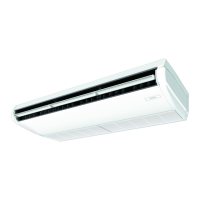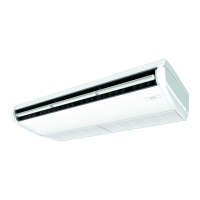Do you have a question about the Daikin FHQ100BVV1B and is the answer not in the manual?
System dismantling, refrigerant, oil, and parts must be handled by qualified installers per regulations.
Batteries must be removed from the remote and disposed of separately per local and national regulations.
Check system type (pair, simultaneous, multi, heat pump, cooling only) with dealer before use.
Understand group control (1 remote: 16 units) and two remote control systems for indoor units.
Identifies and describes the main parts of the indoor and outdoor units for reference.
Highlights critical safety precautions for operation, installation, repair, and handling of the unit.
Covers earthing, lightning surges, flood damage, and avoiding specific environments for operation.
Details safe practices like ventilation, avoiding flammable sprays, cleaning, and child supervision.
Specifies indoor and outdoor temperature/humidity ranges for cooling and heating operations.
Advises on selecting well-ventilated areas, professional wiring, and minimizing running noises.
Guides on using the remote, powering on/off, and initial setup for operation.
Explains defrost cycle, its indicators, and how to adjust air flow direction.
Tips for efficient operation, including temperature adjustment, ventilation, and preventing direct airflow.
Advises turning off the main power for long periods and refers to filter cleaning prompts.
Stresses interrupting power supply before accessing terminals and safe cleaning practices.
Step-by-step guide on cleaning air filters, suction grilles, and panels.
Instructions for cleaning and preparing the unit for extended periods of non-operation.
Addresses scenarios where the system doesn't start immediately or enters standby mode.
Explains specific display codes and how operating modes differ in multi-systems.
Discusses fan speed control and airflow direction differences from settings.
Actions for safety device activation, improper switch function, water leaks, and error codes.
Procedures for power failure, blown fuses/breakers, and water leaks before contacting dealer.
Checks for power failures, blown fuses, and tripped circuit breakers for non-operation.
Checks for blockages and clogged filters when the system stops after initial operation.
Covers reasons for poor cooling/heating like blockages, dirty filters, improper settings, and open doors/windows.
System dismantling, refrigerant, oil, and parts must be handled by qualified installers per regulations.
Batteries must be removed from the remote and disposed of separately per local and national regulations.
Check system type (pair, simultaneous, multi, heat pump, cooling only) with dealer before use.
Understand group control (1 remote: 16 units) and two remote control systems for indoor units.
Identifies and describes the main parts of the indoor and outdoor units for reference.
Highlights critical safety precautions for operation, installation, repair, and handling of the unit.
Covers earthing, lightning surges, flood damage, and avoiding specific environments for operation.
Details safe practices like ventilation, avoiding flammable sprays, cleaning, and child supervision.
Specifies indoor and outdoor temperature/humidity ranges for cooling and heating operations.
Advises on selecting well-ventilated areas, professional wiring, and minimizing running noises.
Guides on using the remote, powering on/off, and initial setup for operation.
Explains defrost cycle, its indicators, and how to adjust air flow direction.
Tips for efficient operation, including temperature adjustment, ventilation, and preventing direct airflow.
Advises turning off the main power for long periods and refers to filter cleaning prompts.
Stresses interrupting power supply before accessing terminals and safe cleaning practices.
Step-by-step guide on cleaning air filters, suction grilles, and panels.
Instructions for cleaning and preparing the unit for extended periods of non-operation.
Addresses scenarios where the system doesn't start immediately or enters standby mode.
Explains specific display codes and how operating modes differ in multi-systems.
Discusses fan speed control and airflow direction differences from settings.
Actions for safety device activation, improper switch function, water leaks, and error codes.
Procedures for power failure, blown fuses/breakers, and water leaks before contacting dealer.
Checks for power failures, blown fuses, and tripped circuit breakers for non-operation.
Checks for blockages and clogged filters when the system stops after initial operation.
Covers reasons for poor cooling/heating like blockages, dirty filters, improper settings, and open doors/windows.
| Brand | Daikin |
|---|---|
| Model | FHQ100BVV1B |
| Category | Air Conditioner |
| Language | English |












